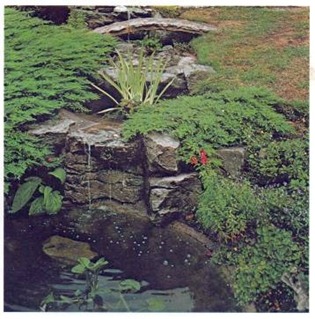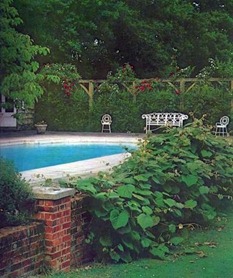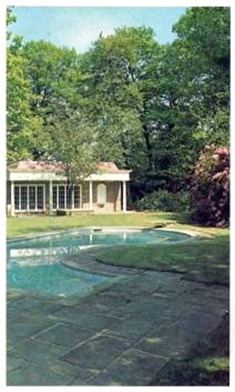





From the earliest times when gardening developed into an art form in the long pre-Christian civilisations of Asia Minor, water has been an integral part of gardens. Pools, fountains, rills, ponds— water in all sizes from a puddle to a lake can be seen in gardens of every age. Of course it is not without significance that the earlier cultures which had gardens, right up until the middle of the last millenium, were in warm climates. Here the sight, sound and even smell of water equated with luxury and a vision of a paradise on earth.
It might be thought that gardening in countries like the ones renowned for their moisture would not be so keen on using water. But this is not so. Almost everyone would like to have a pond in their garden even if only a relatively small proportion of people actually get round to making the effort to get one. For effort there certainly is, though with plenty of reward, both in construction and in subsequent management.
Water in the garden offers several very particular pleasures. The plantsman will at once conjure up visions of delicious exotics thrusting through the surface and marginals clothing the edge. Others will find fascination in fish and other aquatic life. The more contemplative will enjoy that unique watery mirror of the sky which lightens its patch of ground as nothing else can. Still others will rejoice in water movement, slowly flowing or breaking into a scintillating fountain spray.

All these things are possible — not necessarily at great expense. But it is desirable to introduce a couple of warnings at this point. Firstly, that to introduce water successfully artificially into the garden scene is not easy (this lets out the fortunate few who inherit a stream or even an ever-damp ditch). There is more to it than lining a hole with polythene and turning on the tap. Secondly it is just not possible to combine all the desiderata in one spot. Some, indeed, are mutually anti-pathetic. Water lilies, for example, will not succeed in moving water and will languish and die (actually drown) under the spray of a fountain. So, as with other areas of the garden, the question has to be asked: what do I want? And why? From this point a constructive move forward is possible.
It is especially difficult, if not impossible to incorporate an informal pool into a small garden with any hope of making it appear at all natural. The same problem occurs with rock gardens, so often indeed that these two features are apt to be linked. A hole is dug for a pond and the spoil produces an adjacent heap to make a ‘rockery’. On a large scale with suitable backing this can be a lovely combination. Even here, however, a difficulty arises with planting the pool. Water-side plants are inevitably large in scale; their evolutionary adaptions to copious moisture makes this so. Hence they tend to dwarf plants (and indeed the site itself) whose own morphological modifications to mountain sides makes them so much smaller. For this reason those irregular glass fibre pond liners are best avoided. They constrict design. Much better to start the other way round: work out the pool’s raison d’etre, its size and shape and then find the liner.
In asserting the practical difficulties of irregular pools on a small scale, the inevitable corollary must be the recommendation of formal simple shapes. Association with paving and hence the terrace is both practically desirable and visually right. Water always provides a focus of attention and access to it, therefore, needs to be especially convenient. A rectangular or L-shaped pool of only 2 or 3 sq m (6 to 9 sq ft) in area provides a splendid link between terrace and lawn. If this is associated, as so often, with a change in level, one of the pool walls may well be at convenient sitting height. This puts the water surface and the water’s contents in a position to be the better enjoyed.
 The smaller the area of water, the more restrained the planting must be both of aquatics in the pool and of marginals at the edge. There is little point in having a pool if its surface is so covered with leafy growth that it resembles a perfectly ordinary flower border. Hence it may be only possible to have one of the smallest water lilies such as Nymphaea tetragon or N. x pygmaea helvola and an aquatic iris, Iris laevigata variegata for example, as textural contrast in one corner. Depth of water, again, presents restrictions. Less than 30 cm (1 ft) makes solid winter freezing a possibility, with resulting death for fish and certain exotic plants as well. This is, of course, perfectly adequate if the role is solely that of sky reflection.
The smaller the area of water, the more restrained the planting must be both of aquatics in the pool and of marginals at the edge. There is little point in having a pool if its surface is so covered with leafy growth that it resembles a perfectly ordinary flower border. Hence it may be only possible to have one of the smallest water lilies such as Nymphaea tetragon or N. x pygmaea helvola and an aquatic iris, Iris laevigata variegata for example, as textural contrast in one corner. Depth of water, again, presents restrictions. Less than 30 cm (1 ft) makes solid winter freezing a possibility, with resulting death for fish and certain exotic plants as well. This is, of course, perfectly adequate if the role is solely that of sky reflection.
Twice that is about right for most horticultural and aesthetic needs but the danger to young children at least to the age of five must be seen as being omnipresent. Every year toddlers are drowned in small garden pools and to possess unprotected water is to flirt with death. A sensible compromise is to design the children’s sandpit of a size and position where it can be converted into a pool when circumstances permit. Such adaptability is mentioned in the post on the Family Garden.
The ownership or prospect of water gardening is apt to lead even the most prosaic into flights of fancy which should be recognised as such. There appear to be inevitable associations in the mind: water, summer, drifting through curtains of cascading foliage, tea in the country and so on, is typical. It leads to a pair of weeping willows being planted, one at each end of a coffin-sized pool. In two years the pool is out of sight and in ten the house disappears as well.
Plants in scale are essential. The weeping effect is better obtained by one of the smaller bamboos: Arundinaria murieliae for example, or even the corkscrew hazel (Corylus avellana contorta) or Nandina domestica in a protected spot.
The loveliest pools are those where plant growth exists in each habitat from deep water through the shallow edges to marshy ground.
As this is what happens in nature there are numbers of delightful species for every condition. When constructing an area of artificial water where none occurred before the moisture is only within the lining material. If the edge immediately plunges to the full depth of the pool, marginal and bog plants are obviously out unless platforms for pockets of soil or large sunken containers are made.
Pool construction has gone through something of a revolution of late. Until recently, concrete was the only normal possibility. It is still best in formal situations but the effort needed to construct a garden pool is considerable. Always buy premixed concrete; the amount needed for a minimum of a 15 cm (6in) bottom and 10cm (4in) sides is surprisingly large. Reinforcing bars are desirable to key bottom to sides and the whole will have to be done within pre-constructed shuttering which is later removed. A keyword here is permanence, so design and position needs great care if time, effort and money are not to have been misplaced. New concrete must be finished with a seal (proprietary materials are available) to prevent exudations poisoning the water for fish and plant life — though three or four changes of water will have the same effect. Incidentally, draining home pools can be difficult. One method combines siphoning the majority of the water by hose-pipe from pool to a main-drainage manhole. The rest is then disposed of through a drain in the pond itself. This is made at building time by inserting a screw-top flagon with its bottom broken into the concrete base. So long as a small soakaway of broken bricks is provided underneath, the residue of any pool emptying is easily lost.
Much easier, though potentially of shorter life, are pools lined with modern, man-made, water-proof materials. Design dangers of fibre glass have already been mentioned. However a rectangular liner with near-vertical sides could be admirable. Shallow dish-shaped ones are difficult to disguise as being anything but what they are: avoid any shape like a diseased kidney.
Thick gauge polythene, treated to resist rapid degeneration from ultra-violet light is doubtless the cheapest method of containing water in the garden. This is laid on a layer of sand in the excavated hole and gradually filled with water, the increasing weight of which causes the membrane exactly to fill the hole. Black is the most satisfactory colour to use. The more definitely permanent butyl liners, which are made to size, are also most satisfactory in black. These provide a professional finish more easily. ‘Finish’ is the vital word here. Regardless of the material of pool construction it is essential that its surround is good. This is for access and to mask the edges of the construction material. Water lapping grass is a charming idea in truly natural surroundings of some size; in the garden, however, paving is bound to be the answer, at least fronting the pool. The back could be a retaining wall or even a carefully planted border. Flagstones are laid to overhang the water by some 5 cm (2in), this produces a shadow which hides the pool’s lining. It also gives the pool the impression of cool depths unless it is very shallow. Water in the garden is peculiarly a fact of artifice. Facets of the design should combine to make this artifice appear natural — this is almost impossible — but necessary.
 There is little doubt that of all the desirable garden features a swimming pool is the most difficult to fit satisfactorily into the general garden scene. So much so in fact that keen gardeners have got to be persuaded by their families before, as it might be said, they take the plunge.
There is little doubt that of all the desirable garden features a swimming pool is the most difficult to fit satisfactorily into the general garden scene. So much so in fact that keen gardeners have got to be persuaded by their families before, as it might be said, they take the plunge.
If space permits it is wise to consider a swimming pool garden in its own right, separate and separated from the rest of the garden. Seclusion is certainly desirable. If the facilities for swimming are available in the privacy of the garden, it is pleasant to be free from the conventions of dressing demanded by public bathing.
In the case of a young family the warnings offered regarding ornamental pools are no less to be taken seriously. A swimming pool is bound to be a draw for any young child, but a slip on the edge could mean disaster. For a number of reasons therefore if a door can be. Shut on the area, so much the better.
It is natural that the sunniest spot should be chosen. Heating methods whether by use of conventional fossil fuels or solar panels are unlikely to be more than supplements to the normal effect of sun on the water and water’s natural ability to hold heat reasonably well. Cooling effects are increased in windy situations which add more points to the idea of enclosure. This, provided by fencing or walls well-clothed with suitable plants, can also be helped by the sort of aquatic duvet which is made to be pulled over a pool to reduce radiant heat loss at night.
 In a small garden the number of places which will take a swimming pool are necessarily limited and the effect on neighbours should not be underestimated. The glad summer cries of happy bathers are not always welcome over the fence, and offering an open invitation to swim in order to keep neighbours even marginally sweet is apt to be a bore. Here again thick planting will help to absorb noise.
In a small garden the number of places which will take a swimming pool are necessarily limited and the effect on neighbours should not be underestimated. The glad summer cries of happy bathers are not always welcome over the fence, and offering an open invitation to swim in order to keep neighbours even marginally sweet is apt to be a bore. Here again thick planting will help to absorb noise.
Obviously very careful professional advice regarding ground levels, availability and disposal of water, types of pool lining, heating methods and cost must be taken. They fall outside the scope of this website which is concerned with the garden as a whole and the visual effect of its parts. It may be that pool-builder and garden planner are not in accord and here as dispassionate a view as possible of the whole and its component parts must be taken.
Actual time spent in the water by the fortunate owners, their families (and the inevitable fair-weather friends who haven’t a pool yet) is very short, taken over the year. Here is another reason for not letting it dominate the whole garden. Even in the season more time is spent on the edge thinking about getting in, or in chairs after the exertion of having done so.
A pool then must be part of a terrace/patio complex. Here an ambience can be created to encourage an atmosphere of Mediterranean warmth, however illusory in actual fact. A paving surround must be sufficient that little water splash reaches grass or other plants. They resent chlorine or its modern alternatives. Coy ‘his’ and ‘her’ changing rooms are no longer a part of home-swimming pools which have moved into small gardens but if the sitting area can contain a small shelter perhaps fronting the heating unit, where chairs and the inevitable impedimenta of pool maintenance can be kept, all the better.
As with a normal terrace and its beds, shapes should be kept simple. Variations on the rectilinear are invariably best; those resembling foetal tadpoles seem more suited to Hollywood and are more difficult to construct. Again terrace planting helps the effect. Containers of brightly cascading summer annuals and those like tobacco plants and petunias which become highly scented on hot evenings are right. Weight and balance is given by the cordyline cabbage palms, New Zealand flax, and other exotic looking plants. Large-leaved climbers on the walls such as Vitis coignetiae and Aristolochia mafrophylla compound the effect. Considered thus, a pool really can add to the pleasures of a garden without detracting from its visual effect.
Copyright © www.100flowers.win Botanic Garden All Rights Reserved